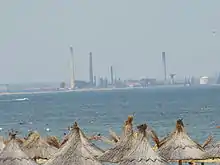Petrochemical industry in Romania
The territory of present-day Romania started producing oil in 1857; oil facilities became an important strategic military target in 1916 during World War I. The Kingdom of Romania was the largest producer of oil in Europe during World War II (with the exception of USSR whose primary oil source was in Azerbaijan), and the oil extracted from Romania was essential for Axis military operations (as was highlighted in Hitler's speech made in 1942).[1][2] Allied bombers attacked the Romanian petrochemical industry near Ploiești heavily (see Operation Tidal Wave) before the Soviet Red Army occupied the oilfields in August 1944. After the war, significant reconstruction and expansion took place under the communist regime. Since 1989, most of the industry has been privatized.

Possessing substantial oil-refining capacities, present-day Romania has a particular interest in the Central Asia-Europe pipelines and seeks to strengthen its relations with some Arab States of the Persian Gulf. With 10 refineries and an overall refining-capacity of approximately 504,000 bbl/d (80,100 m3/d), Romania has the largest refining industry in the eastern European region. Romania's refining-capacity output far exceeds domestic demand for refined petroleum products, allowing the country to export a wide range of oil products and petrochemicals — such as lubricants, bitumen, and fertilizers — throughout the eastern European region.[3]
In 2017, just 5 refineries had the capability of producing, the capacity having fallen to 13.7Mt/year. [4]
Refineries

This is an incomplete list of oil refineries in Romania:
- Petrobrazi Refinery, (Petrom/OMV), 90,000 bbl/d (14,000 m3/d)
- Petrotel Lukoil Refinery, (LUKOIL), 68,000 bbl/d (10,800 m3/d)
- Petromidia Constanţa Refinery, (Rompetrol), 100,000 bbl/d (16,000 m3/d)
- Vega Ploieşti Refinery, (Rompetrol), 20,000 bbl/d (3,200 m3/d)
- Petrolsub Suplacu de Barcău Refinery, (Petrom/OMV), 15,000 bbl/d (2,400 m3/d)
Dormant refineries:
- Astra Refinery, (Interagro), 20,000 bbl/d (3,200 m3/d)
- Steaua Romană Câmpina Refinery, (Omnimpex Chemicals), 15,000 bbl/d (2,400 m3/d)
Closed refineries:
- Arpechim Refinery, (Petrom/OMV), which used to process 70,000 bbl/d (11,000 m3/d)[4]
- RAFO Oneşti Refinery, (Calder A), which used to process 70,000 bbl/d (11,000 m3/d)[4]
Petrochemical processing platforms
Romania has closed down the majority of the petrochemical processing platforms. Those remaining are:
See also
1857 - First drilling of oil wells at Bend, northeast of Bucharest, on the Romanian side of the Carpathians; this year is registered as a beginning of Romania’s oil production. It happened 11 years after the drilling of the first oil well in Baku (in Bibi-Heybat settlement) in 1846.
References
- "VIDEO Înregistrare senzațională cu Hitler: "Fără petrolul din România nu aș fi atacat niciodată URSS-ul"".
- "A Zero Job! Shoveling Out Refuse from the Hot Pools of Oil That Comes up from a Spouting Well". World Digital Library. 1923. Retrieved 2013-05-30.
- http://www.gasandoil.com/goc/news/nte30277.htm Archived 2010-12-15 at the Wayback Machine Romania has the largest power sector in south-eastern Europe.
- "Petrochemical industry in Romania". 21 May 2018.
External links
- Romanian Petroleum History
- www.geohelp.net/world.html
- Mirbabayev Miryusif. Brief history of the first oil drilling wells in Baku region - "Noema" (Romania), 2018, v.XVII, p.175-185
- Vassiliou Marius. Historical dictionary of petroleum industry; 2nd edition - 2018, Lanham MD: Rowman and Littlefield-Scarecrow Press. p. 593
- Marius Vassiliou, Miryusif Mirbabayev. US and Azerbaijani oil in the Nineteenth Century: Two Titans. - USA, Lexington Books Publisher, 2022. - 259 p.